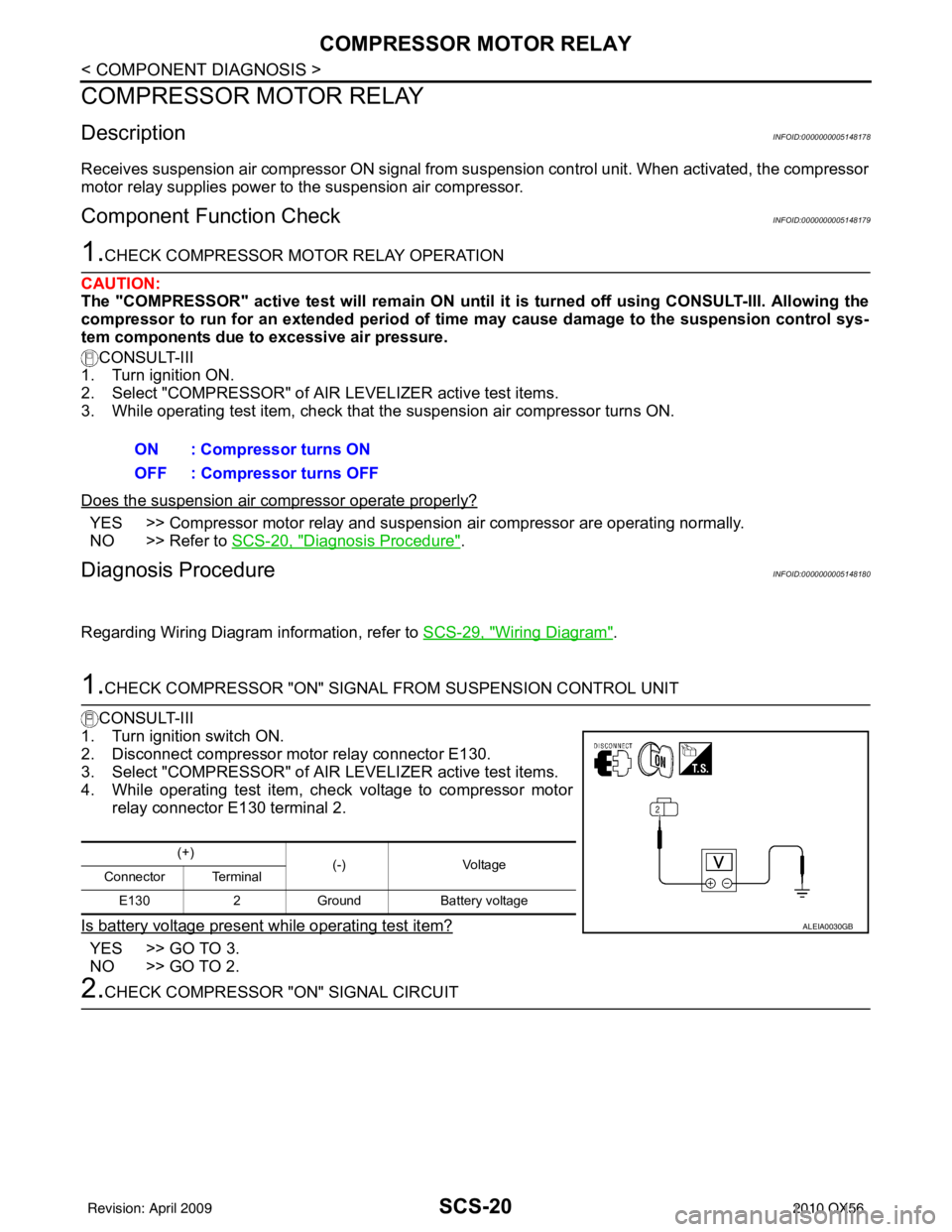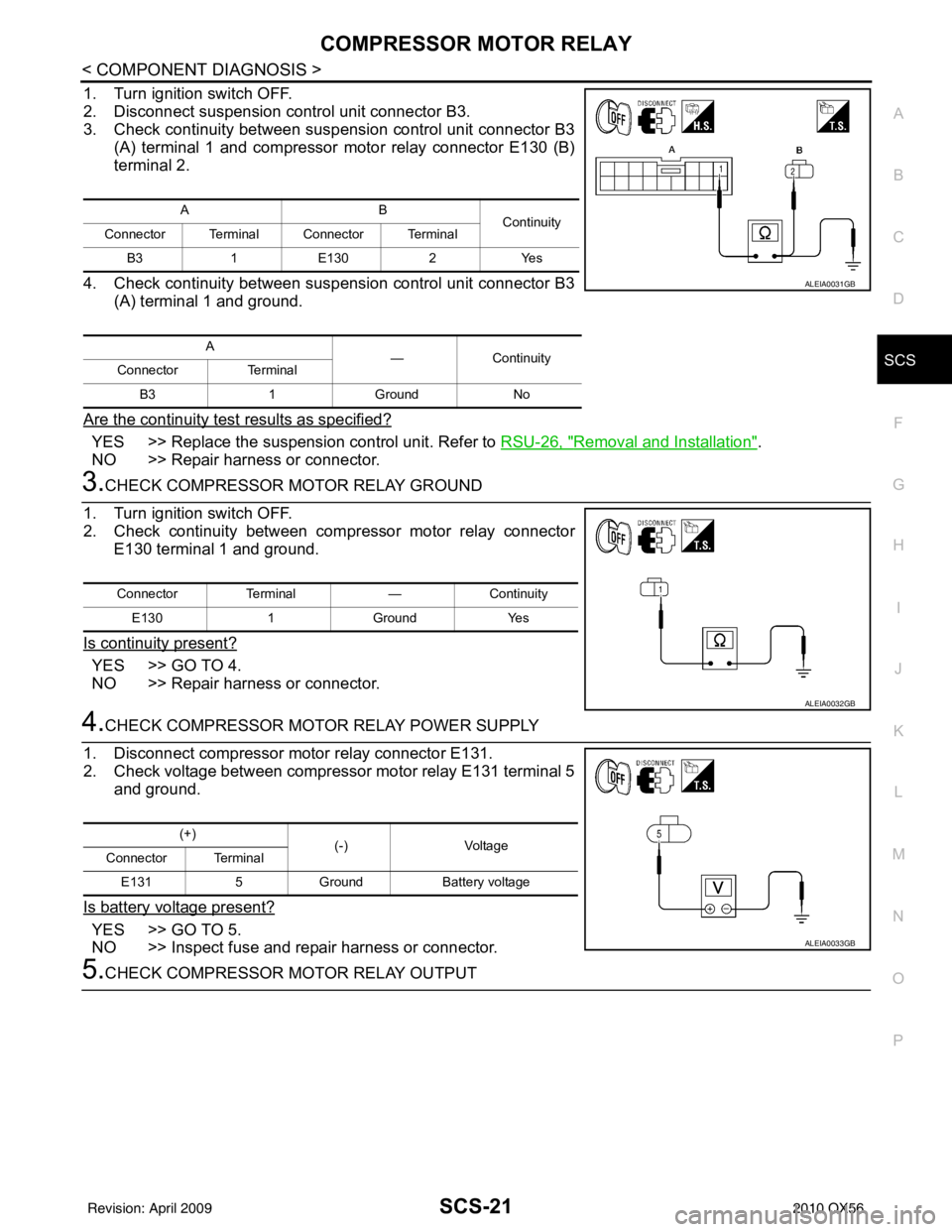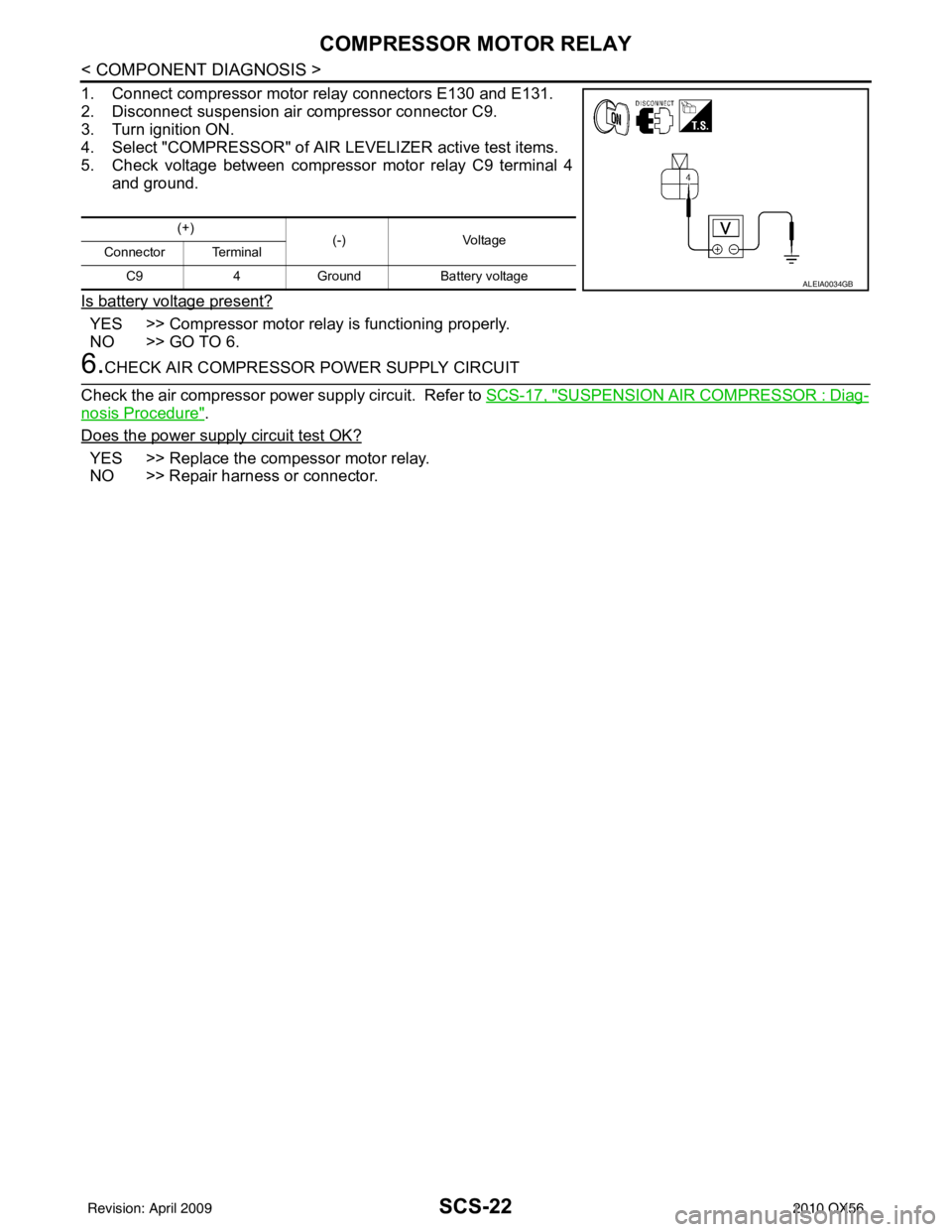2010 INFINITI QX56 relay
[x] Cancel search: relayPage 3252 of 4210

SCS-20
< COMPONENT DIAGNOSIS >
COMPRESSOR MOTOR RELAY
COMPRESSOR MOTOR RELAY
DescriptionINFOID:0000000005148178
Receives suspension air compressor ON signal from suspension control unit. When activated, the compressor
motor relay supplies power to the suspension air compressor.
Component Function CheckINFOID:0000000005148179
1.CHECK COMPRESSOR MOTOR RELAY OPERATION
CAUTION:
The "COMPRESSOR" active test will remain ON until it is turned off using CONSULT-III. Allowing the
compressor to run for an extended period of time may cause damage to the suspension control sys-
tem components due to excessive air pressure.
CONSULT-III
1. Turn ignition ON.
2. Select "COMPRESSOR" of AIR LEVELIZER active test items.
3. While operating test item, check that the suspension air compressor turns ON.
Does the suspension air compressor operate properly?
YES >> Compressor motor relay and suspension air compressor are operating normally.
NO >> Refer to SCS-20, "
Diagnosis Procedure".
Diagnosis ProcedureINFOID:0000000005148180
Regarding Wiring Diagram information, refer to SCS-29, "Wiring Diagram".
1.CHECK COMPRESSOR "ON" SIGNAL FROM SUSPENSION CONTROL UNIT
CONSULT-III
1. Turn ignition switch ON.
2. Disconnect compressor motor relay connector E130.
3. Select "COMPRESSOR" of AIR LEVELIZER active test items.
4. While operating test item, check voltage to compressor motor relay connector E130 terminal 2.
Is battery voltage present while operating test item?
YES >> GO TO 3.
NO >> GO TO 2.
2.CHECK COMPRESSOR "ON" SIGNAL CIRCUIT ON : Compressor turns ON
OFF : Compressor turns OFF
(+)
(-)Voltage
Connector Terminal
E130 2Ground Battery voltage
ALEIA0030GB
Revision: April 20092010 QX56
Page 3253 of 4210

COMPRESSOR MOTOR RELAYSCS-21
< COMPONENT DIAGNOSIS >
C
DF
G H
I
J
K L
M A
B
SCS
N
O P
1. Turn ignition switch OFF.
2. Disconnect suspension control unit connector B3.
3. Check continuity between suspension control unit connector B3 (A) terminal 1 and compressor motor relay connector E130 (B)
terminal 2.
4. Check continuity between suspension control unit connector B3 (A) terminal 1 and ground.
Are the continuity test results as specified?
YES >> Replace the suspension control unit. Refer to RSU-26, "Removal and Installation".
NO >> Repair harness or connector.
3.CHECK COMPRESSOR MOTOR RELAY GROUND
1. Turn ignition switch OFF.
2. Check continuity between compressor motor relay connector E130 terminal 1 and ground.
Is continuity present?
YES >> GO TO 4.
NO >> Repair harness or connector.
4.CHECK COMPRESSOR MOTOR RELAY POWER SUPPLY
1. Disconnect compressor motor relay connector E131.
2. Check voltage between compressor motor relay E131 terminal 5 and ground.
Is battery voltage present?
YES >> GO TO 5.
NO >> Inspect fuse and repair harness or connector.
5.CHECK COMPRESSOR MOTOR RELAY OUTPUT
AB Continuity
Connector Terminal Connector Terminal
B3 1E130 2Yes
A —Continuity
Connector Terminal
B3 1Ground No
ALEIA0031GB
ConnectorTerminal —Continuity
E130 1Ground Yes
ALEIA0032GB
(+)
(-)Voltage
Connector Terminal
E131 5Ground Battery voltage
ALEIA0033GB
Revision: April 20092010 QX56
Page 3254 of 4210

SCS-22
< COMPONENT DIAGNOSIS >
COMPRESSOR MOTOR RELAY
1. Connect compressor motor relay connectors E130 and E131.
2. Disconnect suspension air compressor connector C9.
3. Turn ignition ON.
4. Select "COMPRESSOR" of AIR LEVELIZER active test items.
5. Check voltage between compressor motor relay C9 terminal 4and ground.
Is battery voltage present?
YES >> Compressor motor relay is functioning properly.
NO >> GO TO 6.
6.CHECK AIR COMPRESSOR POWER SUPPLY CIRCUIT
Check the air compressor power supply circuit. Refer to SCS-17, "
SUSPENSION AIR COMPRESSOR : Diag-
nosis Procedure".
Does the power supply circuit test OK?
YES >> Replace the compessor motor relay.
NO >> Repair harness or connector.
(+) (-)Voltage
Connector Terminal
C9 4Ground Battery voltage
ALEIA0034GB
Revision: April 20092010 QX56
Page 3260 of 4210

SCS-28
< ECU DIAGNOSIS >
SUSPENSION CONTROL UNIT
ECU DIAGNOSIS
SUSPENSION CONTROL UNIT
Reference ValueINFOID:0000000005148190
TERMINAL LAYOUT
PHYSICAL VALUES
AWLIA1640ZZ
Terminal
(Wire color) Description
ConditionReference value
(Approx.)
+ – Signal nameInput/
Output
1
(V) Ground Compressor relay output Output Ignition
switch ON Air levelizer raising vehicle
ride height
Battery voltage
3
(W) Ground Height sensor input
InputIgnition
switch
ON —0
.2 V - 4 .8 V
5
(R) Ground VREF output (height sen-
sor)
OutputIgnition
switch ON —5
V
6
(G/R) Ground IGN power supply
InputIgnition
switch ON or
START —
Battery voltage
7
(W/L) Ground BAT power supply
InputIgnition
switch OFF —
Battery voltage
8
(G/W) Ground Diagnostic K-line Input/
Output ——
—
9
(SB) Ground Exhaust valve output Output Ignition
switch ON Air levelizer lowering vehi-
cle ride height (venting)
Battery voltage
10
(BR) Ground Warning lamp output Output Ignition
switch
ON Warning lamp ON
0V
Warning lamp OFF Battery voltage
14
(L) Ground Height sensor ground Output Ignition
switch ON —
Less than 0.2V
15
(BR/W) Ground Generator input
InputIgnition
switch ON Charge light ON
0V
Charge light OFF Battery voltage
16
(B) Ground
Suspension control unit
ground InputIgnition
switch
ON —
Less than 0.2V
Revision: April 20092010 QX56
Page 3267 of 4210
![INFINITI QX56 2010 Factory Service Manual SUSPENSION CONTROL UNITSCS-35
< ECU DIAGNOSIS >
C
DF
G H
I
J
K L
M A
B
SCS
N
O P
Compressor relay [C1802] • Driving transistor for compressor relay is OFF and monitor
voltage continues at a high le INFINITI QX56 2010 Factory Service Manual SUSPENSION CONTROL UNITSCS-35
< ECU DIAGNOSIS >
C
DF
G H
I
J
K L
M A
B
SCS
N
O P
Compressor relay [C1802] • Driving transistor for compressor relay is OFF and monitor
voltage continues at a high le](/manual-img/42/57032/w960_57032-3266.png)
SUSPENSION CONTROL UNITSCS-35
< ECU DIAGNOSIS >
C
DF
G H
I
J
K L
M A
B
SCS
N
O P
Compressor relay [C1802] • Driving transistor for compressor relay is OFF and monitor
voltage continues at a high level for more than 10 seconds.
• Driving transistor for compressor relay is ON and monitor voltage continues at a low level for more than 5 seconds. SCS-10, "DiagnosisProcedure".
Exhaust solenoid [C1803] • Driving transistor for exhaust valve solenoid is OFF and
monitor voltage continues at a high level for more than 10
seconds.
• Driving transistor for exhaust valve solenoid is ON and mon- itor voltage continues at a low level for more than 5 seconds. SCS-11,
"DiagnosisProcedure".
Vehicle height adjusting malfunc-
tion (compressor)[C1804] Continuous compressor relay ON time is more than 120 sec-
onds. SCS-12,
"DiagnosisProcedure".
Vehicle height adjusting malfunc-
tion (exhaust solenoid)[C1805] Continuous exhaust valve solenoid ON time is more than 120
seconds. SCS-13,
"DiagnosisProcedure".
Vehicle height sensor locking mal-
function [C1806] Output sensor voltage variation
±0.02V is more than 100 sec-
onds when vehicle height range is normal. SCS-14, "
Diagnosis Proce-
dure".
Sensor 5V malfunction [C1807] Sensor reference voltage is less than 0.8V or more than 6V for
20 seconds. SCS-15,
"DiagnosisProcedure"
Integral time malfunction by sup-
plying air [C1808]A suspension air compressor ON request has been in effect
for 180 seconds and the suspension air compressor has not
activated during that time. SCS-16,
"DiagnosisProcedure".
Revision: April 20092010 QX56
Page 3268 of 4210

SCS-36
< SYMPTOM DIAGNOSIS >
SUSPENSION CONTROL SYSTEM
SYMPTOM DIAGNOSIS
SUSPENSION CONTROL SYSTEM
Symptom TableINFOID:0000000005148193
AIR LEVELIZER
SymptomPossible causeReference page
Inoperative • Suspension control unit
• Compressor motor relay
• Suspension air compressorSCS-37, "
Diagnosis Proce-
dure"
System does not raise • Suspension control unit
• Height sensor
• Compressor motor relay
• Suspension air compressor
• Leak in system
• Restriction in systemSCS-38, "Diagnosis Proce-
dure"
System does not lower
• Suspension control unit
• Height sensor
• Compressor motor relay
• Suspension air compressor
• Restriction in systemSCS-39, "Diagnosis Proce-
dure"
CK SUSP indicator lamp always ON with key ON
• CK SUSP indicator la
mp control circuit
• Suspension control unit SCS-26, "Description"
Revision: April 20092010 QX56
Page 3361 of 4210
![INFINITI QX56 2010 Factory Service Manual SEC-10
< FUNCTION DIAGNOSIS >[WITH INTELLIGENT KEY SYSTEM]
INTELLIGENT KEY SYSTEM/ENGINE START FUNCTION
FUNCTION DIAGNOSIS
INTELLIGENT KEY SYSTEM
/ENGINE START FUNCTION
System DiagramINFOID:0000000005 INFINITI QX56 2010 Factory Service Manual SEC-10
< FUNCTION DIAGNOSIS >[WITH INTELLIGENT KEY SYSTEM]
INTELLIGENT KEY SYSTEM/ENGINE START FUNCTION
FUNCTION DIAGNOSIS
INTELLIGENT KEY SYSTEM
/ENGINE START FUNCTION
System DiagramINFOID:0000000005](/manual-img/42/57032/w960_57032-3360.png)
SEC-10
< FUNCTION DIAGNOSIS >[WITH INTELLIGENT KEY SYSTEM]
INTELLIGENT KEY SYSTEM/ENGINE START FUNCTION
FUNCTION DIAGNOSIS
INTELLIGENT KEY SYSTEM
/ENGINE START FUNCTION
System DiagramINFOID:0000000005147067
System DescriptionINFOID:0000000005147068
INPUT/OUTPUT SIGNAL CHART
Intelligent Key Unit
IPDM E/R
BCM
SYSTEM DESCRIPTION
• The engine start function of Intelligent Key system is a system that makes it possible to start and stop the
engine without using the key. It verifies the electroni c ID using two-way communications when pressing the
ignition knob switch while carrying the Intelligent Key, which operates based on the results of electronic ID
verification for Intelligent Key using two-way communications between the Intelligent Key and the vehicle.
NOTE:
The driver should carry the Intelligent Key at all times.
Switch/Input signal Input signal to
Intelligent Key unit Intelligent Key unit
function Actuator/Output signal
Key switch Mechanical key
(insert/remove)
Engine start function• KEY warning lamp/buzzer
• Steering lock solenoid
• Starter relay request (to IPDM E/R)
• Inside key antenna
(Front and rear center console, over-
head console, luggage area)
• Key interlock solenoid
Ignition knob switch
Ignition knob
(push/release)
Steering lock solenoid Steering lock
(lock/unlock)
Inside key antenna
(Front and rear center console, over-
head console, luggage area) Intelligent key
(inside antenna detection
area or not.)
Switch/Input signal Input signal to
IPDM E/R IPDM E/R function
Actuator/Output signal
Transmission range switch P, N range Engine start function• Starter relay
• Starter motor
Switch/Input signal Input signal to
BCM BCM function
Actuator/Output signal
Key switch Brake
(press/release)
Engine start function• Inside key antenna
(Front and rear center console, over-
head console, luggage area)
ALKIA0925GB
Revision: April 20092010 QX56
Page 3362 of 4210
![INFINITI QX56 2010 Factory Service Manual INTELLIGENT KEY SYSTEM/ENGINE START FUNCTIONSEC-11
< FUNCTION DIAGNOSIS > [WITH INTELLIGENT KEY SYSTEM]
C
D
E
F
G H
I
J
L
M A
B
SEC
N
O P
• Intelligent Key has 2 IDs (for Intelligent Key and for NA INFINITI QX56 2010 Factory Service Manual INTELLIGENT KEY SYSTEM/ENGINE START FUNCTIONSEC-11
< FUNCTION DIAGNOSIS > [WITH INTELLIGENT KEY SYSTEM]
C
D
E
F
G H
I
J
L
M A
B
SEC
N
O P
• Intelligent Key has 2 IDs (for Intelligent Key and for NA](/manual-img/42/57032/w960_57032-3361.png)
INTELLIGENT KEY SYSTEM/ENGINE START FUNCTIONSEC-11
< FUNCTION DIAGNOSIS > [WITH INTELLIGENT KEY SYSTEM]
C
D
E
F
G H
I
J
L
M A
B
SEC
N
O P
• Intelligent Key has 2 IDs (for Intelligent Key and for NATS). It can perform the door lock/unlock operation and
the engine start operation when the registered Intelligent Key is carried.
• When the Intelligent Key battery is discharged, it can be used as emergency back-up by inserting the
mechanical key set in the Intelligent Key to the ignition key cylinder. At that time, perform the NATS ID verifi-
cation. If it is used when the Intelligent Key is carried, perform the Intelligent Key ID verification.
• If the ID is successfully verified, and when the igniti on knob switch is pressed, steering lock will be released
and initiating the engine will be possible.
• The door lock/unlock operation can be performed when t he Intelligent Key battery is discharged, by operat-
ing the driver door key cylinder using the mechanical key set in the Intelligent Key.
• Up to 4 Intelligent Keys can be registered (including the standard Intelligent Key) on request from the owner.
NOTE:
• Refer to DLK-21, "
INTELLIGENT KEY : S ystem Description" for any functions other than engine start func-
tion of Intelligent Key system.
PRECAUTIONS FOR INTELLIGENT KEY SYSTEM
• For vehicles equipped with the In telligent Key system, the transponder [the chip for NATS ID verifi-
cation] is integrated into the Inte lligent Key. Therefore, the Intelligent Key alone is capable of provid-
ing security clearance for the engine to start. Al so, when the mechanical key alone is inserted into
the key cylinder, performs the NATS ID verification to allow the engine to start. For vehicles without
Intelligent Key system, the transponder is integrated into the mechanical key which must be inserted
into the key cylinder to perform the NATS ID verification to allow the engine to start.
OPERATION WHEN INTELLIGENT KEY IS CARRIED
1. When the ignition knob switch is ON, the Intelligent Key unit transmits the request signal to the Intelligent
Key.
2. The Intelligent Key receives the request signal and transmits the Intelligent Key ID signal to the Intelligent Key unit.
3. The Intelligent Key unit receives the Intelligent Ke y ID signal and verifies it with the registered ID.
4. Intelligent Key unit transmits the steering lock/unlock signal to steering lock solenoid if the verification
results are OK. For detail of key warning message operation, refer to DLK-38, "
System Description".
5. Release of the steering lock.
6. BCM transmits the starter request signal via CAN communication to IPDM E/R and turns the starter relay in IPDM E/R ON if BCM judges that the engine start condition is satisfied.
7. IPDM E/R turns the starter control relay ON when receiving the starter request signal.
8. When shift position is in P or N position, battery power is supplied through the starter relay and operate the starter motor and to start the cranking.
CAUTION:
If a malfunction is detected in the Intelligen t Key system, the “KEY” warning message will be dis-
played in the combination meter. At th at time, the engine cannot be started.
OPERATION RANGE
Engine can be started when Intelligent Key is inside the vehicle. However, sometimes engine might not start
when Intelligent Key is on instrument panel or in glove box.
OPERATION WHEN MECHANICAL KEY IS USED
When the Intelligent Key battery is discharged, performs the NATS ID verification between the integrated tran-
sponder and BCM by inserting the mechanical key into the key cylinder, and then the engine can be started.
For details relating to starting the engine using mechanical key, refer to SEC-14, "
System Description".
STEERING LOCK OPERATION
Steering is locked by steering lock solenoid when ignition switch is in the LOCK position (the ignition knob is
released) and key switch is OFF (key is removed from ignition key cylinder).
Revision: April 20092010 QX56